Back to Journals » Journal of Pain Research » Volume 15
Research Trends of Moxibustion Therapy for Pain Treatment Over the Past Decade: A Bibliometric Analysis
Authors Xia Y, Sun R, Li R , Ren L, Wang Y , Fang J
Received 10 June 2022
Accepted for publication 16 August 2022
Published 20 August 2022 Volume 2022:15 Pages 2465—2479
DOI https://doi.org/10.2147/JPR.S374564
Checked for plagiarism Yes
Review by Single anonymous peer review
Peer reviewer comments 2
Editor who approved publication: Dr Houman Danesh
Yunfan Xia,1 Ruohan Sun,1 Rongrong Li,1 Leilei Ren,1 Yiyi Wang,1 Jianqiao Fang2
1The Third Clinical Medical College of Zhejiang Chinese Medical University, Hangzhou City, People’s Republic of China; 2The Third Affiliated Hospital of Zhejiang Chinese Medical University, Hangzhou City, People’s Republic of China
Correspondence: Jianqiao Fang, 23 Qingchun Road, Hangzhou City, People’s Republic of China, Tel +86(0)571-87238254, Fax +86(0)571-87238005, Email [email protected]
Background: Accumulate evidence indicated that moxibustion has a positive effect on pain treatment. However, the bibliometric analysis of moxibustion on pain remains uncertain. Herein, this study aimed to explore the current hotspots and the research trends over the past decade to bring a great panorama in this field.
Methods: Publications were retrieved from the database Web of Science Core Collection (WoSCC) related to moxibustion therapy for pain treatment from January 1, 2012, to December 31, 2021. CiteSpace and Excel were applied to analyze the volume of publications, journals, cited journals, dual-map analysis, countries, institutes, authors, references, and keywords with citation bursts.
Results: A total of 360 publications were retrieved from 2012 to 2021. The annual number of publications increased steadily with some fluctuations over the past 10 years. “The Evid Based Complement Alternat Med” and “the Gut” were the top-cited journals in frequency and centrality. China and Shanghai University of Traditional Chinese Medicine were the most prolific country and institutions, respectively. Among authors, Huangan Wu was the most active author with the highest cited frequency. Jun Xiong, Fanrong Liang and Guixing Xu held the articles with higher centrality. In the ranking of frequency and centrality in cited references, the top one was the article published by Shamseer L and Deng HY, respectively. “Acupuncture” was the keyword with the highest frequency. Pain disease (including rheumatoid arthritis, knee osteoarthritis, herpes zoster), research method (including randomized controlled trial), and risk (including quality of life, economic burden, physical and psychological problems) were the hotspots and frontier trends in this field.
Conclusion: This bibliometric study reveals the current status and research trend in the treatment of pain with moxibustion. The formulation with bibliometric analysis further elicits hot spots and frontier issues in this field.
Keywords: moxibustion, pain, CiteSpace, bibliometric analysis
Introduction
Pain is an unpleasant sensory and emotional perception associated with actual or underlying tissue pathology, which can bring major clinical, social, and economic problems in communities around the world. Notably, pain appears to have a greater negative effect on the quality of life than other diseases, and is also the greater cause of disability around the world.1 It was estimated that more than 20% of the population visit the clinic with pain as the main complaint each year.2 Additionally, pain also creates enormous economic pressure on society, with a total cost of about 3.0% of GDP.3 Unfortunately, treatment options for pain are poorly targeted due to the complex etiology and recurring symptoms. As commonly identified, pain disease can be the classification by time (acute or chronic), etiology (traumatic, pathological, neurogenic, etc.), location (head and neck, spine and joint, etc.) and other methods. Pharmacological therapy options can relieve pain in a short time but the safety concerns of using muscle relaxants, non-steroidal anti-inflammatory drugs or other painkillers need to be fully evaluated. Thereby, effective complementary and alternative therapies attract both patients and practitioners.4
Moxibustion, a typical therapeutic procedure of traditional Chinese medicine (TCM), which restores the function of visceral organs and meridians by applying heat from burning herbs such as moxa to a certain area or acupoints, is widely sought after and used in the current healthcare system.5 It cures disease by stimulating specific spots on the skin to treat many medical conditions such as asthma, colds and influenza, irritable bowel syndrome (IBS), cancer-related fatigue, disorders of the spinal column, pain, and others.6–10 Accumulating evidence indicates that the combined effect of thermal effects and non-thermal radiation effects of pharmacological responses such as smoke and moxa extracts contribute significantly to the overall analgesic efficacy of moxibustion treatment.11
Preliminary studies were carried out to show the benefits of moxibustion in recent years. The current discussions show that moxibustion treatment was an efficient and safe option for the treatment of pain, including arthritis,9 dysmenorrhea,10 low back pain or neck pain,12 and some other disorders. These trials had been shown that moxibustion can significantly relieve pain and improve function in patients. However, the kinds of literature in this field were diversified and had not been systematically classified and sorted out. Therefore, bibliometric analysis was needed to summarize the current research trend and elicit hotspots in this field. These dissertations seek to investigate the use of moxibustion in analgesia aiming to analyze the current status of moxibustion research for pain disease.
Bibliometrics is a quantitative analysis of published academic literature by using mathematical and statistical methods, and it is a statistical analysis and quantitative tool to study publications.13 Based on mathematical and statistical tools, bibliometrics is used to measure established and emerging research areas through co-authorship, co-citation, and co-occurrence analyses in a certain research field.14 CiteSpace software typically falls into bibliometric visualization tools that can visualize and analyze emerging trends and transition patterns in scientific literature widely.15
This study aims to explore the current status of year, countries, journals, research areas, authors, keywords, and explore hot topics and emerging trends in the field of moxibustion for pain treatment over the past 10 years by using bibliometric analysis.
Methods
Data Acquisition
All data in this study were collected from the core collection database for WoS via the Zhejiang Chinese Medical University Library website including Science Citation Index Expanded (SCI-Expanded), Social Sciences Citation Index (SSCI), Arts & Humanities Citation Index (A&HCI) and Emerging Sources Citation Index (ESCI) on April 3, 2022. The search strategy was TS=(moxibustion OR moxa OR Moxabustion) AND TS=(pain* OR nocicep* OR ache* OR analg* OR headache* OR migraine* OR stomach ache* OR abdominal ache* OR toothache* OR neck painweek pain OR back pain OR musculoskeletal pain OR sciatic* OR fibromyalg* OR neuralgi* OR hyperalg* OR radiculalg* OR arthralg* OR causalg* OR earache* OR cancer pain OR osteoarthritis OR arthritis). The publications’ timespan ranged from 2012 to 2021. A total of 360 records were retrieved in this study. In addition, the countries, categories and language of publications were not restricted. The specific search strategies and results are shown in Table 1.
 |
Table 1 The Topic Search Query |
Analysis Tool
Descriptive statistical analysis, co-occurrence analysis and cluster analysis were executed by using CiteSpace 5.8 and Excel 2016, the former mainly to achieve analysis of journals, cited journals, dual-map of cited journals, countries, institutions, authors, references, and keywords; while the latter was mainly applied to depict the annual publications. The parameters of CiteSpace were set as below: (1) time slicing: from January 2012 to December 2021, per slice represent 1 year; (2) term source: all options were selected; (3) selecting criteria: factor k = 25; (4) pruning: pathfinder, pruning sliced networks and pruning merged network were chosen. In this multivariate, time-sharing, dynamic visualization knowledge graph, each node represented an element. The size of the circle represented the frequency of items and the width of lines served as the connection between items. The large size and warm color of a node implied that it has recently exploded with high frequency. The thick links between nodes meant a strong co-leading relationship. Additionally, the nodes with wide purple around them often represented the literature with higher centrality.
Results
Analysis of Annual Publications
A total of 360 publications were included in this study. As shown in Figure 1, the number of publications increased obviously from 20 in 2012 to 71 in 2021. From 2012 to 2018, the number of publications fluctuated at a low level, with the lowest number of publications being in 2012 (with only 20 publications). However, the number of publications increased rapidly in 2019. Furthermore, the number of publications increased continually is reach 71 from 2019 to 2021. The trend of publications indicated that moxibustion, as a complementary treatment, has received more attention, and more studies have been carried out to observe the efficacy of moxibustion on pain in recent years.
 |
Figure 1 The number of moxibustion therapy for pain treatment publications from 2012 to 2021. |
Analysis of Journals and Cited Journals
Results of our statistical analysis revealed that the total number of journals that published articles on moxibustion treatment for pain was 97. The top 10 journals of moxibustion therapy for pain treatment are shown in Table 2 and the publishers of these journals were mostly located in the United States or England. Evidence-Based Complementary and Alternative Medicine (Evid-based Compl Alt) was the most productive journal (with 62 publications, 17.22% of 360), followed by Medicine (60, 16.67% of 360), and Journal of Traditional Chinese Medicine (20, 5.56% of 360). Furthermore, Lancet Gastroenterology & Hepatology the journal with the highest impact factor (IF), with an IF of 18.486.
 |
Table 2 Top 10 Journals Related to Moxibustion Therapy for Pain Treatment |
The analysis of the co-citation of journals indicated a distribution of significant knowledge sources in a particular field. Cited journal map consists of a total of 430 references (as shown in Figure 2 and Table 3). In terms of centrality, the top 5 journals were Gut, Journal of clinical epidemiology, JAMS Journal of Acupuncture and Meridian Studies, BMC Complementary and Alternative Medicine, and BMC Research Notes, respectively.
 |
Table 3 Cited Journals and Centrality Related to Moxibustion Therapy for Pain Treatment |
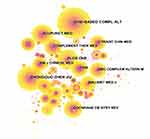 |
Figure 2 Cited journal maps related to moxibustion therapy for pain treatment from 2012 to 2021. |
A dual-map overlay with citing and cited matrices of journals was generated by using CiteSpace 5.8 software (Figure 3). The left side of the map represents citing journals while the right is cited journals which are linked with four citation paths in this illustration. The green paths illustrate that studies published in “medicine, medical, clinical” journals tended to cite journals primarily in the domains of “Molecular, Biology, Genetics” and “health, nursing, medicine”. The paths colored with an orange showcase that research published in “Molecular, Biology, Immunology” journals preferred to quote journals mostly in the domains of “Molecular, Biology, Genetics” and “health, nursing, medicine”.
 |
Figure 3 A dual-map overlay of journals related to moxibustion therapy for pain treatment from 2012 to 2021. |
Distribution of Countries and Institutions
The distribution of the countries map consists of 24 nodes and 30 links (Figure 4). The 360 references were published by researchers from 24 countries, indicating that 24 countries participated in the study of moxibustion therapy for pain. As a result, China (267) had the most publications, followed by South America (37), Korea (36) and England (13) (Table 4). Considering the country centrality, England (0.83) ranked first among the countries, followed by Germany (0.7) and China (0.48).
 |
Table 4 The Top 5 Publications and Centrality of Countries Related to Moxibustion Therapy for Pain Treatment |
 |
Figure 4 A country cooperation map related to moxibustion therapy for pain treatment from 2012 to 2021. |
CiteSpace was applied to estimate the 238 institutions that have made significant contributions in this field (Figure 5). Shanghai University of Traditional Chinese Medicine (44) ranked first for publications, followed by Chengdu University of Traditional Chinese Medicine (43), and Jiangxi University of Traditional Chinese Medicine (27). Besides, the top 3 institutions with higher centrality were Chengdu University of Traditional Chinese Medicine, the University of Hong Kong, and Shanghai University of Traditional Chinese Medicine (Table 5). Therefore, based on the publications and centrality, we found that the institutions from China paid more concerned with the research of moxibustion treatment in pain currently, and Shanghai University of Traditional Chinese Medicine and Chengdu University of Traditional Chinese Medicine was the strongest cooperation institutions.
 |
Table 5 The Top 10 Publication and Centrality of Institutions Related to Moxibustion Therapy for Pain Treatment |
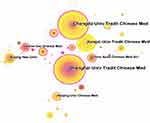 |
Figure 5 An institution cooperation map related to moxibustion therapy for pain treatment from 2012 to 2021. |
Analysis of Authors
Co-authors map consists of 315 nodes and 418 links using CiteSpace software (Figure 6), indicating that the total eligible publications in this study were published by 315 authors. The map of authors was designed to reveal the most prolific author or co-author, as well as demonstrate the closeness of collaboration among the authors, which could provide information on influential research groups and potential collaborators, and help researchers establish cooperative relationships. The top 3 productive authors were Huangan Wu (19), Jun Xiong (18), Luyi Wu (12) (Table 6). Among them, the most prolific author was Huangan Wu, from the Shanghai University of Traditional Chinese Medicine in China, with 19 articles. In terms of centrality, the top 4 authors were Jun Xiong (0.06), Fanrong Liang (0.06), Guixing Xu (0.05) and Adi Wirawan Tjahjono (0.05). From the network, few links between these top authors suggest an urgent need to strengthen the collaboration between these researchers.
 |
Table 6 The Top 5 Publication and Centrality of Authors Related to Moxibustion Therapy for Pain Treatment |
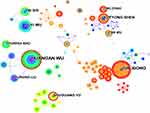 |
Figure 6 Map of cited author related to moxibustion therapy for pain treatment from 2012 to 2021. |
Lin Zhao has published many articles in this field recently, and the content of his articles is comparatively original. One of the studies suggested that moxibustion is an effective and safe approach for pain relief in osteoarthritis of the knee.16 System reviews and meta-analysis had proved the effectiveness of moxibustion therapy; nonetheless, there was still a lack of high-quality articles.17 Those scholars with high attainments in this field could create more cooperation and exchanges so as to complete more high-quality articles and scientific research achievements.
Analysis of Cited-Reference
Co-citation implies that two articles appear together in the reference list of a third cited article thus the two articles form a co-citation relationship. Co-citation suggests that the cited literature and corresponding research are related in content, and the literature usually contains high-quality content which has significant influence in a particular field of research. By analyzing the literature with high co-citation frequency and centrality, the knowledge foundation of the subject could be obtained. Moreover, the relationship between literature co-citation is likely to change with time. A total of 403 references were generated from 360 records to analyze cited-references. The top 5 cited-references were shown in Figure 7, Table 7. The study published by Shamseer L in 2015 had the highest co-citation counts, followed by Li A (2016) and Song GM (2016), intending to clarify the clinical effect of moxibustion treatment for Knee Osteoarthritis (KOA) through a systematic Review and Meta-Analysis. The review published by Li A concluded that moxibustion can mitigate the symptoms of KOA to some extent.18 Yang MX conducted a randomized controlled trial to identify the synergy between moxibustion therapy and conventional drug.10 With respect to centrality, the first was the article published in 2013 by Deng HY who reviewed on the mechanism of moxibustion effects, among which the most acceptable view is adjusting the nerve-endocrine-immune network and circulatory system to achieve the effects of preventing and curing diseases.19
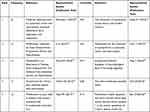 |
Table 7 The Top 5 Frequency and Centrality of Citation Related to Moxibustion Therapy for Pain Treatment |
To investigate the clusters of a cited-references, the logarithmic likelihood ratio (LLR) algorithm was used to assess nominal terms extracted from the keyword list of articles to the naming of clusters to explore research models and emerging trends in knowledge systems, and to obtain key information from cited references. Seventy-one clusters were generated with a modularity value of 0.86777, indicating that clustering results were highly reliable (Figure 7B). As the figure showed the silhouette was 0.8785, which demonstrated that the resulting network community structure was significant and our cluster was acceptable concurrently. The top 5 clusters were “osteoarthritis”, “primary osteoporosis”, “clinical research”, “knee osteoarthritis” and “metabolomics”. Among these groups, the largest one was “osteoarthritis”, which consisted of 38 reference articles. Cluster #53 angina pectoris was depicted in most vivid yellow which indicated a new research direction that had recently emerged.
Analysis of Keywords
The research trend in this field is often represented by analyzing keywords, the increase in occurrence and citation frequency is considered to predict the research frontier in this field. A keyword co-occurrence network containing 302 notes and 538 links (Figure 8). “Acupuncture”, “pain”, “randomized controlled trial”, “moxibustion”, and “management” were the top 5 keywords with the highest frequencies; while “meta-analysis”, “acupuncture treatment”, “randomized controlled trial”, “irritable bowel syndrome”, and “ankylosing spondylitis” were the top 5 keywords with the highest centrality (Table 8). Interestingly, “randomized controlled trial” is of high position both in frequency and centrality. RCT was essential for evaluating the efficiency of a certain therapeutic method, but inadequate reporting and design elicited a high level of concern to formulate proper ethical standards. Hence, developing the Consolidated Standards of Reporting Trial (CONSORT) statement is employed promising to improve the quality of reporting of RCTs.20 As double-blind is difficult to meet in clinical trials, single-blind trials were chosen to deploy. The findings suggested that one possible explanation for relieving the joint swelling and pain symptoms in rheumatoid arthritis patients was that moxibustion restricts inflammatory factor release.21 Another trial delivered the consequence that the effectiveness of moxibustion has been implicated in the quantity of stimulus. Experiments displayed that penetrating stimulation could gain yet more moxibustion sensation in analgesia and enhance the quality of life of patients with migraine without aura.22 Management and prevalence are in the front position in the ranking list of frequency which indicates moxibustion is one of the complemental therapies in prophylaxis and treatment. KOA is the only specific disease in the ranking list that demonstrates a relatively mature research trend in this field. IBS ranks highly in the list of centrality makes us investigate the interconnection between moxibustion therapy and chronic visceral hyperalgesia. Moxibustion has its advantages in treating chronic pain in the spine and joints such as ankylosing spondylitis and arthritis. Additionally, the moxibustion method needs to manipulate by following the specific acupuncture point. As different acupuncture points are selected in studies, more attention should be paid to assessing the therapeutic effect of distinct acupuncture points.
 |
Table 8 Top 10 Keywords Related to Moxibustion Therapy for Pain Treatment |
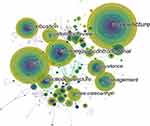 |
Figure 8 Map of keywords related to moxibustion therapy for pain treatment from 2012 to 2021. |
The top 20 keywords with the strongest citation burst from 2012 to 2021 are shown in Figure 9. “Systematic review” and “knee osteoarthritis” were ranked at the top, while “herpes zoster” has burst recently. Research progress of moxibustion treatment of pain can be drawn from the strongest citation bursts of keywords evolution. “Suspended moxibustion” and “spinal cord” exerted their influences earlier, while “herpes zoster” and “knee osteoarthritis” were lucubrated in 2020 and arouse wide public concern hitherto. Particular attention in this area of research has been given to moxibustion therapy in treating certain pain diseases. These keywords will be further discussed in the following section.
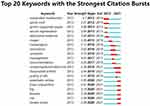 |
Figure 9 Top 20 keywords with the strongest citation bursts. The red color represents the keyword was cited in high frequency and the green color represents in low frequency. |
Discussion
General Information
To the best of our knowledge, this is the first bibliometric study of moxibustion therapy for pain management. The general information concluded from the results is listed as follows: (1) The annual number of publications boosted steadily over the past 10 years and the output was expected to grow swiftly which indicates a promising direction in this research field. (2) “The Evid Based Complement Alternat Med” and “the Gut” were the top-cited journals in frequency and centrality. (3) The most prolific country is China, which successfully provided crucial research foundation trends. Given that the other top countries were of poor yield, efforts should be paid to strengthen collaboration between countries to potentiate their output. Shanghai University of Traditional Chinese Medicine and Chengdu University of Traditional Chinese Medicine have profound academic backgrounds, and the institutions can achieve more high-quality results by cooperative closely. (4) Huangan Wu was the most active author with the highest cited frequency. (5) The top cited reference in frequency and centrality was the article published by Shamseer L and Deng HY respectively. (6) Pain disease (eg, arthritis, ankylosing spondylitis, herpes zoster, IBS), research method (eg, RCT), and risk assessment (eg, quality of life, economic burden, physical and psychological problems) were the hotspots and frontier trends in this field according to the analysis of the keyword.
Research Hotspots
The results of co-citation demonstrated the fact that literature usually contains high-quality and strong impacts in this research field. Moreover, it may represent the research foundation of a certain field. The current research type relies on meta-analysis and RCTs, and the content involves mechanism and clinical. One of the frontier research hotpots is osteoarthritis which provides novel perspectives on moxibustion therapy indications. Osteoarthritis is a prevalent pain disease that affects people all over the world. Moxibustion, because of the thermal effect on the local area, often has a therapeutic efficacy to analgesia. Recent research has shown that it directly promotes knee cartilage repair, in the meanwhile regulates the composition of the intestinal flora to prohibit inflammatory factor release.23 Some RCTs have suggested that moxibustion therapy is a safe choice for treatment.9,24,25 However, the top-cited were the standard of meta-analysis, indicating that the number of RCTs in this field is relatively limited and the quality needs to be improved. Therefore, researchers should strengthen the study on efficacy evaluation, to promote the view of moxibustion in the treatment of pain and push forward further research in this field.
Interestingly, as we searched publications related to moxibustion and pain, we found that IBS ranked forward in the list with high centrality as an important research spot. IBS is a functional gastrointestinal (GI) disorder that manifests as abdominal pain and a change in bowel habit.26 The research found abundance and diversity of intestinal microflora in the GI were risks of IBS.27 Alteration of intestinal microbiota activated the immune system to foster the formation of inflammatory cytokines to induce intestinal inflammation. However, a recent study found moxibustion treatment can reverse the changes in microbiota profiles and balance GI function.28 Besides, the NOD-like receptor family pyrin domain containing 6 (NLRP6) inflammasome signaling is considered a medium for regulating gut microbiota and intestinal homeostasis.29 Another research indicated that mild moxibustion can control NLRP6 inflammasome signaling to alleviate inflammation to achieve analgesia.30 These results discussed how moxibustion contributes to pain relief.
Keywords as Indicators of Emerging Trends
Recent emerging trends in moxibustion therapy on pain disease were identified according to the keyword bursts from 2012 to 2021, as follows:
(1) Rheumatoid arthritis (RA): Studies have shown that inhibition of relevant cytokines can reduce joint neovascularization to alleviate pain and dysfunction caused by RA.31 Interestingly, moxibustion can regulate inflammatory cytokines released in RA at the molecular level. Downregulated hypoxia-inducible factor-1α/vascular endothelial growth factor level can effectively relieve pain intensity in rheumatoid arthritis.32 In addition, moxibustion may diminish the level of inflammatory factors to improve the symptoms of swelling and pain.21 Further technologies in the specific mechanism of moxibustion to RA are urgently warranted.
(2) KOA: Moxibustion therapy is an efficient intervention without pharmacological and surgical for KOA. Current studies have proved that moxibustion is effective in the treatment of KOA. However, it is notable that the smoke of bursting moxa is harmful to one’s health. Therefore, it is necessary to find a moxibustion method with less influence of smoke. The study found that maybe smokeless moxibustion can achieve the same therapeutic effect. This will become a new research direction. One exciting recently discovered is that CO2 laser moxibustion is a device as a convenient and environmental substitution that simulates the traditional moxibustion but without smoke or smell.33 Another trial evaluated the effect of the laser moxibustion device with the thermal effect but no smoke is promising for KOA symptoms.9 More smokeless moxibustion therapies are expected to be developed in the future.
(3) Risk: In recent years, the risk of pain diseases attracted more attention from researchers. In particular, suffering from pain disease could raise the occurrence of diverse physical and psychological problems. The high cost of treatment also increases the burden on society.34 Besides, it has an adverse impact on quality of life and physical function. Thus, much more attention should be paid to being aware of the risks of diseases and focusing on prevention and treatment.
(4) Herpes zoster: Herpes zoster can bring health burdens for people of all ages. Complications usually manifest as pain, fever, and itching. The most common is postherpetic neuralgia, which affects one in five people suffering from this disease.35 Moreover, these uncomfortable feelings caused by herpes zoster bring a heavy economic burden from individuals to society.36 Recently, a systematic review and meta-analysis have shown that moxibustion can alleviate postherpetic neuralgia to some extent, which highlights the great potential of moxibustion therapy.37 This review provides a new perspective on interventions for herpes zoster.
In this review, we discuss current adaptable indications of moxibustion therapy, for instance, AS, arthritis, KOA, RA, herpes zoster, IBS and other pain conditions. Most of them are a class of chronic inflammatory conditions affecting the spine or joints and typically fall into musculoskeletal disease. Additionally, our results provide a novel perspective on the therapeutic efficacy and potential of moxibustion therapy in neuralgia and chronic visceral hyperalgesia. These findings provide future possibilities for moxibustion therapy as a complement and alternative to pain management.
Strengths and Limitations
This study has used bibliometrics for the first time to perform a visual analysis of literature related to moxibustion for pain treatment, summarized research status and key research forces in this field, and predicted the research trend. In addition, we have used a variety of methods to analyze data, which is suitable for multi-angle interpretation of conclusions. However, this study has limitations that need to be addressed. This study only analyzed the core collection database for Web of Science, because CiteSpace is currently unable to analyze cited references for other databases. It is anticipated that the improvement of this software will enable the expansion of the selection range for databases in the future.
Conclusion
In conclusion, this study reveals hot spots and frontier issues in the field of moxibustion therapy for pain treatment. The findings presented here are expected to promote the optimization of treatment options.
Data Sharing Statement
The following information was supplied regarding data availability: the raw data can be directly obtained from the WoSCC of Thomson Reuters.
Acknowledgment
Thanks to Prof. Chaomei Chen for opening the use of CiteSpace.
Author Contributions
All authors made substantial contributions to conception and design, acquisition of data, or analysis and interpretation of data; took part in drafting the article or revising it critically for important intellectual content; agreed to submit to the current journal; gave final approval of the version to be published; and agree to be accountable for all aspects of the work.
Funding
This study was supported by the key plan of Zhejiang Province Traditional Chinese Medicine Prevention and Treatment of Major Disease of the Health and Family Planning Commission of Zhejiang Province (No. 2018ZY008). The trial sponsor is the Third Affiliated Hospital of Zhejiang Chinese Medicine University (219 Moganshan Road, Xihu District, Hangzhou City, Zhejiang Province 310005, China, +86-571-88393504). The funders had no role in study design, data collection and analysis, decision to publish, or preparation of the manuscript.
Disclosure
The authors declare that they have no conflicts of interest in this work.
References
1. Dahlhamer J, Lucas J, Zelaya C, et al. Prevalence of chronic pain and high-impact chronic pain among adults - United States, 2016. MMWR Morb Mortal Wkly Rep. 2018;67(36):1001–1006. doi:10.15585/mmwr.mm6736a2
2. Ashar YK, Gordon A, Schubiner H, et al. Effect of pain reprocessing therapy vs placebo and usual care for patients with chronic back pain: a randomized clinical trial. JAMA Psychiatry. 2022;79(1):13–23. doi:10.1001/jamapsychiatry.2021.2669
3. Henschke N, Kamper SJ, Maher CG. The epidemiology and economic consequences of pain. Mayo Clin proc. 2015;90(1):139–147. doi:10.1016/j.mayocp.2014.09.010
4. Gao Z, Zhang J, Liu GF, Ji LX. Research trends from 2010 to 2020 for pain treatment with acupuncture: a bibliometric analysis. J Pain Res. 2021;14:941–952. doi:10.2147/JPR.S300911
5. Region WHOWP. WHO International Standard Terminologies on Traditional Medicine in the Western Pacific Region. Geneva, Switzerland: World Health Organization; 2007.
6. Dubois MY, Chen L. Of low back pain and moxibustion. Pain Med. 2014;15(8):1243–1244. doi:10.1111/pme.12513
7. Han K, Kim M, Kim EJ, et al. Moxibustion for treating cancer-related fatigue: a multicenter, assessor-blinded, randomized controlled clinical trial. Cancer Med. 2021;10(14):4721–4733. doi:10.1002/cam4.4020
8. Bao C, Zhang J, Liu J, et al. Moxibustion treatment for diarrhea-predominant irritable bowel syndrome: study protocol for a randomized controlled trial. BMC Complement Altern Med. 2016;16(1):408. doi:10.1186/s12906-016-1386-4
9. Zhao L, Cheng K, Wu F, et al. Effect of laser moxibustion for knee osteoarthritis: a multisite, double-blind randomized controlled trial. J Rheumatol. 2021;48(6):924–932. doi:10.3899/jrheum.200217
10. Yang M, Chen X, Bo L, et al. Moxibustion for pain relief in patients with primary dysmenorrhea: a randomized controlled trial. PLoS One. 2017;12(2):e0170952. doi:10.1371/journal.pone.0170952
11. Chiu JH. How does moxibustion possibly work? Evid-Based Complementary Alt Med. 2013;2013:198584. doi:10.1155/2013/198584
12. Yuan QL, Guo TM, Liu L, Sun F, Zhang YG. Traditional Chinese medicine for neck pain and low back pain: a systematic review and meta-analysis. PLoS One. 2015;10(2):e0117146. doi:10.1371/journal.pone.0117146
13. Li R, Sun J, Hu H, et al. Research trends of acupuncture therapy on knee osteoarthritis from 2010 to 2019: a bibliometric analysis. J Pain Res. 2020;13:1901–1913. doi:10.2147/JPR.S258739
14. Guo J, Pei L, Chen L, et al. Research trends of acupuncture therapy on cancer over the past two decades: a bibliometric analysis. Integr Cancer Ther. 2020;19:1534735420959442. doi:10.1177/1534735420959442
15. Chen C. Searching for intellectual turning points: progressive knowledge domain visualization. Proc Natl Acad Sci U S A. 2004;101 Suppl 1(Suppl 1):5303–5310. doi:10.1073/pnas.0307513100
16. Zhao L, Cheng K, Wang L, et al. Effectiveness of moxibustion treatment as adjunctive therapy in osteoarthritis of the knee: a randomized, double-blinded, placebo-controlled clinical trial. Arthritis Res Ther. 2014;16(3):R133. doi:10.1186/ar4590
17. Yuan T, Xiong J, Wang X, et al. The effectiveness and safety of moxibustion for treating knee osteoarthritis: a PRISMA compliant systematic review and meta-analysis of randomized controlled trials. Pain Res Manage. 2019;2019:2653792. doi:10.1155/2019/2653792
18. Li A, Wei ZJ, Liu Y, Li B, Guo X, Feng SQ. Moxibustion treatment for knee osteoarthritis: a systematic review and meta-analysis. Medicine. 2016;95(14):e3244. doi:10.1097/MD.0000000000003244
19. Deng H, Shen X. The mechanism of moxibustion: ancient theory and modern research. Evid-Based Complementary Alt Med. 2013;2013:379291. doi:10.1155/2013/379291
20. Altman DG, Schulz KF, Moher D, et al. The revised CONSORT statement for reporting randomized trials: explanation and elaboration. Ann Intern Med. 2001;134(8):663–694. doi:10.7326/0003-4819-134-8-200104170-00012
21. Tao S, Wang X, Liao C, et al. The efficacy of moxibustion on the serum levels of CXCL1 and β-EP in patients with rheumatoid arthritis. Pain Res Manage. 2021;2021:7466313. doi:10.1155/2021/7466313
22. Gao L, Xie J, Li X, et al. Effect and safety of penetrating moxibustion in treatment of migraine without aura: a randomized controlled trial. Chin J Integr Med. 2021;27(12):927–932. doi:10.1007/s11655-021-3327-4
23. Chen Y, Lv J, Jia Y, et al. Effect of moxibustion on the intestinal flora of rats with knee osteoarthritis induced by monosodium iodoacetate. Evid-Based Complementary Alt Med. 2020;2020:3196427. doi:10.1155/2020/3196427
24. Kang HR, Lee YS, Kim SH, et al. Effectiveness and safety of electrical moxibustion for knee osteoarthritis: a multicenter, randomized, assessor-blinded, parallel-group clinical trial. Complement Ther Med. 2020;53:102523. doi:10.1016/j.ctim.2020.102523
25. Lin L, Cheng K, Tan MT, et al. Comparison of the effects of 10.6-μm infrared laser and traditional moxibustion in the treatment of knee osteoarthritis. Lasers Med Sci. 2020;35(4):823–832. doi:10.1007/s10103-019-02863-9
26. Ford AC, Sperber AD, Corsetti M, Camilleri M. Irritable bowel syndrome. Lancet. 2020;396(10263):1675–1688. doi:10.1016/S0140-6736(20)31548-8
27. Joo YE. Alteration of fecal microbiota in patients with postinfectious irritable bowel syndrome. J Neurogastroenterol Motil. 2015;21(1):135–137. doi:10.5056/jnm14133
28. Wang X, Qi Q, Wang Y, et al. Gut microbiota was modulated by moxibustion stimulation in rats with irritable bowel syndrome. Chin Med. 2018;13:63. doi:10.1186/s13020-018-0220-y
29. Elinav E, Strowig T, Kau AL, et al. NLRP6 inflammasome regulates colonic microbial ecology and risk for colitis. Cell. 2011;145(5):745–757. doi:10.1016/j.cell.2011.04.022
30. Bao CH, Wang CY, Li GN, et al. Effect of mild moxibustion on intestinal microbiota and NLRP6 inflammasome signaling in rats with post-inflammatory irritable bowel syndrome. World j Gastroenterol. 2019;25(32):4696–4714. doi:10.3748/wjg.v25.i32.4696
31. Elshabrawy HA, Chen Z, Volin MV, Ravella S, Virupannavar S, Shahrara S. The pathogenic role of angiogenesis in rheumatoid arthritis. Angiogenesis. 2015;18(4):433–448. doi:10.1007/s10456-015-9477-2
32. Gong Y, Yu Z, Wang Y, et al. Effect of moxibustion on HIF-1α and VEGF levels in patients with rheumatoid arthritis. Pain Res Manage. 2019;2019:4705247. doi:10.1155/2019/4705247
33. Guo MH, Zhao L, Wu F, et al. CO(2) laser moxibustion for knee osteoarthritis: study protocol for a multicenter, double-blind, randomized controlled trial. Chin J Integr Med. 2020;26(8):568–576. doi:10.1007/s11655-019-2714-6
34. Cohen SP, Vase L, Hooten WM. Chronic pain: an update on burden, best practices, and new advances. Lancet. 2021;397(10289):2082–2097. doi:10.1016/S0140-6736(21)00393-7
35. Saguil A, Kane S, Mercado M, Lauters R. Herpes zoster and postherpetic neuralgia: prevention and management. Am Fam Physician. 2017;96(10):656–663.
36. Johnson RW, Rice AS. Clinical practice. Postherpetic neuralgia. N Engl J Med. 2014;371(16):1526–1533. doi:10.1056/NEJMcp1403062
37. Wu Q, Hu H, Han D, Gao H. Efficacy and safety of moxibustion for postherpetic neuralgia: a systematic review and meta-analysis. Front Neurol. 2021;12:676525. doi:10.3389/fneur.2021.676525
38. Shamseer L, Moher D, Clarke M, et al. Preferred reporting items for systematic review and meta-analysis protocols (PRISMA-P) 2015: elaboration and explanation. BMJ. 2015;350:g7647. doi:10.1136/bmj.g7647
39. Song GM, Tian X, Jin YH, et al. Moxibustion is an alternative in treating knee osteoarthritis: the evidence from systematic review and meta-analysis. Medicine. 2016;95(6):e2790. doi:10.1097/MD.0000000000002790
40. Vickers AJ, Cronin AM, Maschino AC, et al. Acupuncture for chronic pain: individual patient data meta-analysis. Arch Intern Med. 2012;172(19):1444–1453. doi:10.1001/archinternmed.2012.3654
41. Choi TY, Choi J, Kim KH, Lee MS. Moxibustion for the treatment of osteoarthritis: a systematic review and meta-analysis. Rheumatol Int. 2012;32(10):2969–2978. doi:10.1007/s00296-012-2367-7
42. Tang Y, Yin HY, Rubini P, Illes P. Acupuncture-induced analgesia: a neurobiological basis in purinergic signaling. Neuroscientist. 2016;22(6):563–578. doi:10.1177/1073858416654453
43. Bao CH, Wu LY, Wu HG, et al. Moxibustion inhibits apoptosis and tumor necrosis factor-alpha/tumor necrosis factor receptor 1 in the colonic epithelium of Crohn’s disease model rats. Dig Dis Sci. 2012;57(9):2286–2295. doi:10.1007/s10620-012-2161-0
 © 2022 The Author(s). This work is published and licensed by Dove Medical Press Limited. The full terms of this license are available at https://www.dovepress.com/terms.php and incorporate the Creative Commons Attribution - Non Commercial (unported, v3.0) License.
By accessing the work you hereby accept the Terms. Non-commercial uses of the work are permitted without any further permission from Dove Medical Press Limited, provided the work is properly attributed. For permission for commercial use of this work, please see paragraphs 4.2 and 5 of our Terms.
© 2022 The Author(s). This work is published and licensed by Dove Medical Press Limited. The full terms of this license are available at https://www.dovepress.com/terms.php and incorporate the Creative Commons Attribution - Non Commercial (unported, v3.0) License.
By accessing the work you hereby accept the Terms. Non-commercial uses of the work are permitted without any further permission from Dove Medical Press Limited, provided the work is properly attributed. For permission for commercial use of this work, please see paragraphs 4.2 and 5 of our Terms.

